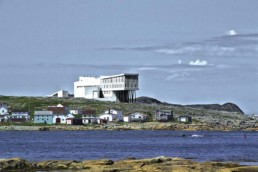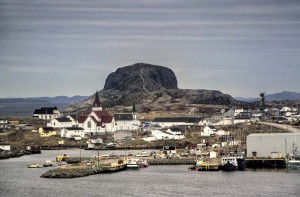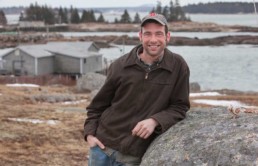A Rock Revived: Newfoundland's Fogo Island
A Rock Revived: Newfoundland's Fogo Island
Fogo Island’s story is one of survival. In modern times, this 92-square-mile island has survived the provincial government’s attempts to resettle the population, the demise of the cod fishery that sustained Newfoundland for centuries, and the severe economic downturn caused by loss of the cod.
But the rugged residents of Newfoundland’s largest island were hanging on for dear life long before Joey Smallwood tried to move them off-island in the 1960s, or the cod fishery closed in 1992. Prior to these crises, the St. John’s salt fish traders had a company-store choke hold on all rural Newfoundland’s fishermen that kept them barely subsisting for more than a century.
The residents of Fogo Island have traditionally done everything they could to keep their island existence viable, against heavy odds. These people, who possess an ingenuity fertilized by the rigors of a subsistence culture and the constraints of island living, have survived, and now may have a chance at thriving, due to the creative efforts of a wealthy native who returned home to live and help her island.
“The first big changes came in 1960 when the government wanted us to resettle and we decided we weren’t leaving. The men formed the co-op—it’s the lifeline of Fogo Island,” said retired teacher Christine Dwyer of Joe Batt’s Arm. “In 1972, we decided that to have better education, we’d amalgamate all the schools. That was the beginning of Fogo Island.”
For its size, Fogo’s unique features are many. It’s home to 11 separate communities with a total island population of just under 2,400. Nine of the communities had schools. Fogo was the first to end the province’s custom of religious schools—one for each denomination no matter how small the town—and create one, central, nondenominational school.
It has a fisheries co-op so innovative that it is used as a model in Ottawa for other communities. It has a native caribou herd. It was the site of the first ground-warning radar station in the North Atlantic during World War II. It has a thriving fishery that replaced the vanished cod, and three fish plants—one each for crab, shrimp, and assorted groundfish, mostly turbot. To save money, the communities amalgamated into one municipal government for the entire island.
Not unique to Fogo were the same troubles that still plague nearly all of rural Newfoundland: a lack of jobs, an outmigration of young people seeking jobs, and, therefore, a dwindling and aging population. But Fogo Island, once again, is defying the odds. Some young people are returning, there’s an uptick in employment, and increased tourism offers the prospect of related small businesses.
THE COBB EFFECT
The increase in tourism may be credited to Zita Cobb. Credit for the returning young people can be divided between Cobb and the proliferating offshore oil industry.
Cobb grew up on Fogo Island, one of seven children of a fishing father. Their dad gave up fishing and moved to the mainland in the 1970s, when small-boat fishermen were forced to invest in larger long-liners to chase the dwindling cod further offshore.
Cobb attended Carleton College in Ottawa and embarked on a round-the-world odyssey of oil company jobs and treks through Africa, ending when she stepped down at age 43 from her job as CFO of a California-based fiber optics company. She cashed in her stock options for millions, sailed her 47-foot yacht around the world for four years, and then returned home to Fogo in 2005.
Cobb began investing in Fogo Island immediately upon her return by giving college scholarships to graduating students, until an island woman pointed out that Cobb was “paying our children to leave.”
“I realized we needed to do something that would make a meaningful long-term difference to folks on the island,” Cobb said. She formed the nonprofit Shorefast Foundation with four goals: Fogo Island arts—residencies that cover artist expenses; “straight-up preservation,” such as restoring old houses and keeping alive the tradition of building punts; business assistance in the form of micro-lending; and the Fogo Island Inn.
Four art studios are now open, with two more planned. Each is near a different community, and is a small, simple, but cleanly beautiful modern structure that doesn’t resemble the island’s typical buildings, but fits in and echoes its stark beauty.
The artists’ studios and the four-story inn, which opened in June 2013, were all designed by a young, Newfoundland-born architect, Todd Saunders, whose Saunders Architecture is based in Norway. The inn is a for-profit business, but it’s owned by Shorefast.
Offering only 29 rooms also makes the inn unusual. Cobb sees it as “big enough, but small enough,” and admits it’s not the typical size for a destination inn.
“Most of the cost is the main infrastructure—heat, kitchen, etc.—so conventional wisdom says you may as well hang as many rooms onto it to get your money back.
“But the inn is a gift to the community, it belongs to the charity; there’s no payback—no five-year payback, no hundred-year payback. That changes everything,” said Cobb. “We are operating a business, so we have to make a profit, but nothing like the investment on capital.”
It’s also a matter of scale: “The more they pay, the fewer people have to come.” When the inn first opened, it won awards for food, design, and hospitality.
Cobb attends high-end tourist shows to sell the inn’s pricey rooms to vacationers. At a recent show in Marrakesh (“You’ve GOT to be there”), she was standing next to representatives of luxurious, extravagant Oman resorts.
“What we have to offer is more ‘embodied,’ ” said Cobb. “Our inn came from the ground and history up. We’re coming at luxury in a different way,” is the pitch.
“Everything is made from natural materials. There are no laminates, just solid wood,” she explained. All the inn’s furniture and light fixtures were built by island craftsmen. The native black spruce, often used for building punts, provides the exterior siding. The rooms are ample, spare and modern, but the furnishings add hominess and tradition.
Island women hooked rugs and sewed more than 200 quilts with traditional island patterns in different weights for different seasons, and each bears the name of the woman who sewed it. As much as possible, materials come from Fogo Island, or at least Newfoundland. Organic cotton wraps the foam mattresses made in Ottawa from rubber harvested sustainably in Indonesia.
“It’s all about new ways with old things,” said Cobb. “When we came up against building codes, we had to figure out the plague of sameness. Every building material is the same size, but people don’t think about human joy. You get joy from specifics.”
Many rooms in the steel-framed, highly insulated inn contain wood-burning stoves to give guests “a warm hearth to gather around,” while solar panels provide hot water for the radiant floor heat and the laundry. Rainwater collectors gather water to flush toilets and provide a heat sink.
FILM ON DEMAND
Jack Stanley first came to visit Fogo Island eight years ago. He bought a book about one of the island villages, Tilting, by Robert Mellin, and brought it back to Montreal with him.
“I dreamed about getting back to Newfoundland. The book was one of the main reasons,” said Stanley. Now he lives in the town of Tilting and works as director of the program for Fogo Island Arts, developing the culture and arts program that includes artist talks at the inn.
“The international residency program is the primary focus,” said Stanley. “Guests at the inn like to visit the artists at the studios.”
In the 1960s, the National Film Board (NFB) of Canada sent people to Fogo as part of a “Challenge for Change,” using film to engage communities that were struggling. The resulting films are now “playing a big part in bringing international tourism here,” said Stanley.
“The NFB is in the process of digitizing every film they’ve produced, and Shorefast has a partnership with them. It’s the first English language e-cinema. The NFB can transfer a film to us via the Internet. We upload it to the server and we can screen it anytime” in the inn’s digital theater, said Stanley. “There’s the potential for a guest to go to the website and request that we screen a particular film. It’s an exciting time.”
Some islanders work at the inn, and many interact with inn visitors through the Community Host Program (CHP). Program coordinator Sandra Cull admits the CHP is really a formalization of the custom of Newfoundlanders—befriending strangers. Her husband, a woodworker, made all the beds in the inn.
“We do what we’ve always done, only now it’s combined with a five-star inn,” said Cull. “The longer I do this, the more I realize it’s a valuable part of coming to Fogo Island. “What visitors do depends on their interest. Sometimes people say they want to do their own thing, and then the next day, they come to me because they’ve overheard what someone else is doing with a host, and they want to do it too.”
Guests may enlist a host to visit a woodworking shop, go aboard a long-liner, take a guided tour of the island’s communities, meet with a boatbuilder, visit an artist, or just have tea in someone’s kitchen. Guests might sign up to spend only an hour, but it usually turns into an afternoon, and often lunch or dinner.
“At this early stage, we have nearly forty people who act as hosts. We’re so lucky that a lot of them are retired, because it’s not a job,” said Cull. “Guests get a taste of the old ways, maybe learn the many uses for traditional punts in the museum in Seldom, or see the history of resettlement at the Fogo Island Marine Interpretation Centre.
“I get so caught up, my husband says, ‘You go to bed and dream about this.’ It’s true. It’s not just about hospitality, it’s about learning,” said Cull. “There’s a couple of ladies in the community—without much warning, I might call them up and say ‘Some guests think they’d like a partridgeberry jam tart,’ and they’ll do it.”
Aidan Penton is one of the community hosts. He’s a boatbuilder, fisherman, and woodworker. Oldest in a family of 13, himself a father of three, Penton is from Joe Batt’s Arm, one of the island villages. He’s also the guy who made all the light fixtures for the inn.
Five years ago he turning dropped caribou antlers on a lathe, making jewelry, letter openers, handles for ice cream scoops, wine bottle stoppers, rug hooks, and more, including the drawer handles for the bureaus he created for his own home. Penton also made the inn’s 400 lamps and sconces. It took nearly seven months, working 10 hours a day.
Making small items is good for the winter months when he’s not fishing.
“To carve a living out of Fogo Island, we have to do everything ourselves because we don’t make a lot of money,” said Penton. “We’re hunter-gatherers, and that occupies a lot of our time. We do our own work on the boat. I go moose and duck hunting. My wife is an avid berry-picker.
“We do a nice bit of cod—salt it and dry it—and the inn buys a lot of it. We dry ours on flakes," a platform built on poles. "There’s a bit of a knack to it,” said Penton.
Often inn guests want to row one of the punts, go aboard his long-liner, or visit his boatbuilding shop.
He thinks the arrival of Shorefast and the Fogo Island Inn is a good thing: “It was time for us to catch a break.
FLAT EARTH OUTPOST
Host Clem Dwyer, a retired special education teacher, picked up a couple at the Gander airport in the fall, and asked why they chose Fogo. The husband said his wife wanted to celebrate her 30th birthday “far, far away.” Dwyer said, “That’s a phrase Zita uses, so that’s how they got here.” The Flat Earth Society calls Fogo Island one of its “four corners of the earth,” and a plaque at Brimstone Head in the town of Fogo proclaims it a “Flat Earth Outpost.”
His hometown, Tilting, has a residency for artists that predates the Shorefast arts program. Last year, he met two Maine fiber artists who spent six weeks on Fogo in the summer of 2013, then returned in November. “Now they’re coming back for six months.”
Textile artists Claudia Brahms and Noel Mount live in Hallowell, Maine. They’ve been traveling to Newfoundland for 10 years to spend two weeks hiking. When they heard about the Tilting residency, they applied. Both are weavers, and Mount is also a photographer.
Roy Dwyer, another community host, is a native of Fogo’s distinctly Irish community of Tilting, where the names, accents, and architecture still reflect its Irish heritage. He’s a fisherman, writer, poet, and storyteller.
“A lot of the old values and structures are gone from my great-grandfathers’ day,” said Dwyer. “In my generation, change is happening rapidly.” Tilting now hosts an annual Irish festival that sees up to 40 people from Ireland attending. Many have found relatives who emigrated generations ago buried in the Tilting cemetery.
Dwyer and others have turned to crab, shrimp, and turbot. Fishing now is financed by banks.
“They are ‘enterprises’ now—a new term, post-moratorium,” he said. “When they retire now, fishermen can sell the ‘enterprise’ and the license, and walk away with a million dollars. We have one of the largest offshore fishing fleets in Newfoundland.”
Some young people are moving back because they have landed jobs in the offshore oil industry.
“If you see a big house going up, those guys are working the supply boats for the oil rigs,” said Dwyer. “My nephew is on an Irving oil tanker, and he built a house next door to me. He works two months on and two months off.”
He’s optimistic about the future, figuring the world will always want more seafood. And the inn means “the world will be beating a path to our door, especially in summer. We’re not going to shrivel up.” While he thinks that the older islanders might not like every aspect of the new, varied economy, he adds that “without the new development, we would disappear.”
AMALGAMATION
In 2011, five existing municipal governments on the island amalgamated into one, called Fogo Island. Robert Greenwood is founding director of the Leslie Harris Centre of Regional Policy and Development at Memorial University in St. John’s.
“The province brought in incentives for communities to amalgamate, and Fogo did it. We encourage municipalities to pool their resources, because small communities with aging populations can’t do much by themselves,” Greenwood said.
Gerard Foley was the first elected mayor of the new Fogo Island town government. Before that he was supervisor of the Fogo Island co-op for 32 years. He likes volunteering to help keep the community viable.
“We want people to have a good experience on Fogo, and getting in and out is one of the challenges,” said Foley. Many residents feel the 60-car ferry will not accommodate an increase in tourism, and the additional trucks to deliver supplies. Already the co-op is dependent on the ferry to bring raw product in and finished product out.
However, as several residents point out, many people who travel to the inn arrive by helicopter.
Foley and his wife Darlene run Foley’s Place in Tilting, one of several new B&Bs on the island. Several years ago, there was only one.
“Fogo Island is one of the most popular destinations in Newfoundland now, because of the marketing done by the inn, and the publicity in all kinds of media,” said Foley. “We’ve seen people from all around the world at our B&B.”
Madonna Penton rescued her old family home in Joe Batt’s Arm. The 100-year-old house was abandoned for several years, and her uncle was selling it.
“He was afraid someone might take it down. He was pleased that I was interested. We did it up a bit. People starting calling—it was all word of mouth. Five years ago we officially made it into a B&B, Landwash Lodging. We don’t charge a barrel of money for the rooms,” she said.
“We have people from all over Europe, China, and Australia come here,” said Penton. “They are so inspired by what they see, they don’t want to leave. They want to buy houses. The people are wonderful.”
The tourists attracted to Fogo by the inn and Shorefast are giving the islanders new pride in their place and their crafts, said Penton. “We used to hate to see the icebergs come because they would make us cold. Now the tourists who travel the world come here to see them. I knew we had beautiful scenery, but we took it for granted. We didn’t think it would be appreciated by rich people from out of town.”
She went to school with Zita Cobb. “For all her money, if you saw her in a roomful of people, you’d never know. She’s done such good things for us. We’re so proud.”
Nadine Decker returned from the West Coast to Fogo to help create a comprehensive socioeconomic plan for the island. “I was tickled to come back to help, but it took longer than anyone expected. When the contract was up, it was time to leave, or find something else to do.” She bought one of the oldest homes in Joe Batt’s Arm and turned it into a guesthouse called Quintal House.
“I’m not a brave business owner. I looked at it for three years before I bought it,” said Decker. “The inn was going up, and my cousin had a café nearby.”
She says there are two camps regarding recent changes. “One camp is nervous about an entity with so much money. I don’t fear Ms. Cobb’s money, because she has a social conscience, and she responds to concerns,” said Decker. “The other money attracted by her money—that’s the part I fear.”
SEVEN SEASONS
Tourists go to Newfoundland primarily in summer, so Cobb said that after the inn’s “super” first season, she thought the inn might close for winter. Instead, she had an influx of families in the fall that surprised her.
Winter on Fogo “is not for the faint of heart,” she added. “We have seven seasons here: summer; berry season [early fall]; the storms of November, when the rocks are crying out for mercy; winter, with February’s wind; March [ice season, with pack ice from the north]; April and May [classic spring, with icebergs]; and June—the traitor. You can’t trust June; it’s neither spring nor summer. You can have all seven seasons in June.”
Some guests never leave the inn in the cold season—there’s plenty to do indoors, between the views from the beautiful rooms, the fine-dining restaurant, the theater, art gallery, library, and sauna.
But place is what the inn is all about, and Cobb wants to build community. “Fogo Island is woven back into the fabric of the world. We want to create a new kind of globalization, so that everyone is connected in a meaningful way.”
In It For The Long Haul
In It For the Long Haul
To many residents and visitors alike, summer on a Maine island means one thing above all others: that most wonderful of culinary and sensory experiences—a Maine lobster dinner—succulent white meat dripping with drawn butter, served near the ocean.
While finding the perfect spot to enjoy a lobster, visitors may stroll along the edges of Maine’s harbors while admiring the sun dancing on a bay dotted with multicolored lobster buoys, rimmed by docks piled high with rectangular traps and filled with scores of lobster boats.
It’s a beautiful sight that lives on in memory and draws travelers back to Maine by the millions. Few visitors realize that behind the idyllic scene lies an increasingly complicated industry, or that many of the harvesters who provide the lobster, the local color, and the memories are struggling to keep their businesses afloat.
Lobster is Maine’s most valuable fishery, and Maine has plenty of lobsters, so landings are not the issue. But the fishery has been faced with a bewildering array of challenges during the past few years—challenges that in a different industry might have driven people to seek another line of work. Especially the young people. But young Maine lobstermen don’t appear to be abandoning the fishery; rather, most seem determined to stick it out at all costs.
On the other hand, younger people—the 18- to 40-year-olds—are not as well-represented in the fishery these days. Only a tiny percentage of young people who held student licenses in recent years went on to acquire commercial licenses. For that, Dave Cousens, president of the Maine Lobstermen’s Association (MLA), has a theory. He believes young people who considered getting into the fishery, from 2005 on, bumped into the low prices and high costs that still plague the fishery today.
“In the late 1990s, lobstering was pretty profitable. Kids could come out of high school and make good money. After 2005, it changed. If they didn’t own stuff, if they didn’t have assets, they really couldn’t make enough money,” said Cousens. “They need boats, a house, a truck. They needed a lot of assets, and the money just wasn’t there. After 2005, kids went out fishing and the money was horrible, so very few were staying in.”
On the other hand, if the young people came from fishing families, they were more likely to get in and stay in. “They had an advantage—their families probably helped with gear and other stuff,” said Cousens. “I think some kids also have a romantic view of lobstering . . . then they get their student licenses, go out for a while, and get a different view,” he added. “I see few kids in that generation who like physical work. They’re used to computers. But if they’re brought up doing the work, they know what to expect.”
Themes emerge when young fishermen speak of their work. They all cite the same reasons for staying in the business: They love being on the water; they love being their own boss; and they love the anticipation of harvesting, and the fact that every day is different, with different problems to solve.
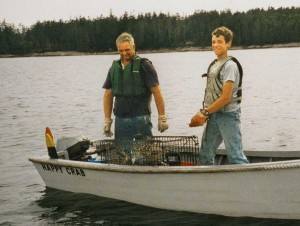
NATHANIEL LANE, 24, who fishes out of Sunshine, a tiny community on Deer Isle, wasn’t brought up in the lobstering life, but took to it quickly. He started fishing at age 10. His father isn’t a fisherman, but Nathaniel went out with a family friend and soon got five traps of his own, fishing out of a small open boat that had belonged to his late grandfather, Fred Heanssler, who was a lobsterman until he was 50, and quit to found Heanssler Oil Co.
“I just caught the bug and focused on building up my gang of traps,” said Lane. “When I was in eighth grade, I had 150 traps.”
Lane’s father was a boatbuilder, now a house builder, who built an 18-foot open wood-and-fiberglass lobster boat for him. “I called it the price is right, because the labor was free,” he said. In junior high, he bought a 30-foot lobster boat called rise and shine that needed lots of work. After extensive renovations, with his dad’s help, he fished that boat for five years, building up to 600 traps.
When he went off to Eastern Nazarene College in Quincy, Massachusetts, he fished alone summers to pay his tuition. He received his business management degree in 2011, but never planned to do anything but fish. In his senior year, he bought another used wooden boat, fairwind, a 37-footer built by Neil MacKay in Prince Edward Island.
“I’m not afraid of wooden boats, or the maintenance,” said Lane. “Older fishermen say they’re more comfortable and slower to respond to weather. I think the next trend among younger fishermen will be getting wooden boats. I plan to continue as long as it’s viable or I can do it,” he said. “As much as it looks like I’m not using my degree, I am. All the decisions I have to make—figuring out my profit margin and expenses—I’m a lot more aware of the business end than I was before I went to college. Before it was just ‘Let’s go fishing.’ ”
Lane admits he’s an optimist by nature, but says he’s also not blind to reality. “A lot of fishermen are optimists, even though I hear a lot of complaints,” he said. “I always say if I listened to other fishermen, I’d never set a trap. But your best information is your own traps coming aboard your own boat. It takes a lot to get into it and years to build your business, so it’s hard to walk away from it.
“You have to watch your bait bill and expenditures,” Lane added, “but if a boat here is doing an average of 1,000 pounds, a boat in Casco Bay might be doing 500 pounds, and that’s a big concern.” Downeast Maine also offers a lot less in the way of alternative work opportunities than southern Maine, so young fishermen who want to stay have to succeed.
ZACH “BUOY” WHITENER, 26, of Long Island in Casco Bay, decided to embark on a career in research instead, after nearly a lifetime of lobstering. Like so many, he also started at the age of 10, but since his family wasn’t a fishing family, he was on his own. He used cast-off traps—wood or wire, whatever he could find—fishing from a rectangular boat he rescued when another islander was throwing it away.
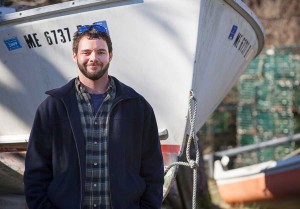
“I called it five tomatoes because I gave him five tomatoes for it,” Whitener said. “I cut the traps in half because they were too big for me. I had that boat for two years.”
In fifth grade, he appeared on a popular public television kids’ show of the time called Zoom, rowing his boat and hauling his traps.
Neighbors helped him build the next boat, a 14-foot rowboat he kept for a couple more years, until he graduated to a bigger one, a skiff he bought in South Thomaston. After that came a 23-foot vessel from Cape Elizabeth. He might have felt the lure of research anyway, but a wrist injured while playing rugby in his sophomore year of high school required surgery that didn’t quite work. A pin still floats around in there, causing pain when he hauls traps.
“I decided to go to the Cape Cod Commercial Hook Fishermen’s Association and be an observer for a summer as an independent contractor,” said Whitener. While earning a degree from Brown University in anthropology, he continued observing out of Chatham, Massachusetts, for five summers, “mostly counting discards.” After graduation he was hired on a grant for two years to do research on alewives at Portland’s Gulf of Maine Research Institute (GMRI).
When the grant ran out, he moved on to the University of the Virgin Islands for a master’s degree in marine studies and the environment, mostly completed now. “I wasn’t really qualified for the job, so I needed more education. I was a scientist by occupation but not education.” After finishing his course work, he took another job with GMRI.
“Lobstering is a surprise. It’s like opening Christmas presents all day long,” said Whitener. “The way it used to be, the more you worked, the more you earned. You got out what you put in, but not anymore. I just really liked research. It takes a long time to answer questions, and you end up with more questions.” He compares research to lobstering in at least one aspect: “It’s problem-solving and figuring out what to do.
“I love lobstering, but I knew I wanted something more,” added Whitener. “It would have been a much harder decision if my wrist was okay.” But, he said, “I still have the boat.”
BEN LOVELL, 25, comes from the Penobscot Bay island of North Haven, where most of his friends are lobstermen. His mother’s a teacher and his dad is a finish carpenter who also taught special education. He didn’t go lobstering at an early age, but tried it for two seasons after graduation from Bowdoin College in 2010.

“I got a call that there was an opening for a sternman,” said Lovell. “I had no experience; I was a total greenhorn when I went out the first day. I had been around it but never did it. It’s challenging. You get to the end of the day and you know you did something. It’s solid manual labor and I enjoyed it. There was a moment when I thought I could be a sternman for quite a while. I never wanted to be a captain and get my own traps, but toward the end I had trouble with my hands, so it was difficult,” Lovell explained.
The lobstering paychecks allowed him to move to Brooklyn, New York, where he lives now and works for Play-Well TEKnologies in an after-school program, teaching young kids engineering by using Legos. Although his history degree with a minor in teaching didn’t prepare him to teach engineering, he said, “I always played with Legos, so it’s not too tricky!
“The kind of knowledge and capability lobstermen have to have—to read the bottom, to know what’s going on out there—it’s something only certain people can do long-term. It’s a die-hard commitment.
“My close friends are pretty stubborn, and they love lobstering,” Lovell said. “Most of my friends are still sternmen. It’s so hard. It takes a lot of commitment to get your own boat and license. The last season the price was pretty terrible, but they’re in it for the long run.”
Young people who choose to continue lobstering clearly will have to adapt to changing conditions, said Bob Baines, longtime Spruce Head fisherman and MLA board member. He doesn’t expect a lot of young fishermen to flee the industry because of tough times. “No one wants to get out. It’s hard, after you’ve worked for yourself, to go and work for someone else, and the kids are more open to new ideas than us older guys,” said Baines. “They’re a little more aware.”
DILLAN CUSHMAN, 23, fishes out of Port Clyde from his 35-foot fiberglass boat, chasin’ crustacean. His father Dennis is a lobsterman. His uncle Gerry serves on the MLA board of directors. To say the Cushmans are an old fishing family is an understatement.
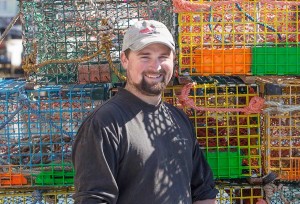
He, like so many, started with his dad at age 10. He went through the required apprenticeship program, also with his dad. Like most of the other dedicated young harvesters, he was going on his own from a skiff by age 14. At 15, Cushman bought a 34-foot Jonesporter, then a 34-foot Duffy, and finally, his latest one.
“I guess we do things differently compared to what it used to be,” said Cushman. “I have to work a lot harder to earn what I get. When I was a kid, the family would take a weekend off during the season and go camping. We can’t do that anymore. Since I’ve been going hard at it, I’ve never seen a good year for prices.”
His fuel bills are particularly high because he chooses to go offshore, chasing Homarus americanus as they move farther out in the fall.
“Not a lot of Port Clyde guys went offshore in the old days, but now the lobsters are moving farther out,” so most of the town’s younger fishermen have federal permits to go offshore, said Cushman. “The price this year was so low—you have to go a little harder if you want to make a living. For the old guys, it was a big thing when the price went under $4, then under $3. Every year it’s different, and last season was definitely a change.”
He plans to do whatever it takes to remain in the lobster fishery, however. “I think I’ll be able to stay in. I think the only thing that helped us this year was the amount of lobsters we caught, so it kind of averaged out, but if it keeps up this way, it will be a lot harder for people. I’m trying to pay everything off, just in case.”
An issue that emerged last season was “shrink,” or the death of a higher-than-usual percentage of lobsters in pounds or retail tanks soon after sale. This is due in part to another change to Maine’s fishery—the unpredictability of “shedders,” or lobsters whose shells are soft because they’ve just molted. Weather has a lot to do with it, said Cushman. “Lobsters are shedding earlier. Last year it was April. This year we had a cold winter, so maybe things will switch around with colder water.”
Shedders used to occur primarily in certain months, but now 90 percent of Maine’s catch during most of the year is shedders, according to statistics revealed at the Maine Fishermen’s Forum in March 2013. June, July, and August of 2012 saw the highest landings of any month previously recorded. Each month was higher than the one before. Dealers and pounds were overwhelmed, and most of the lobsters were the more-vulnerable shedders, so the MLA plans to teach harvesters better handling techniques in an attempt to reduce shrink.
IN THE COUSENS FAMILY, from South Thomaston, sons know what to expect from fishing. Like many Maine harvesters, Dave Cousens comes from a fishing family. He grew up on a lobster boat, fishing with his dad. His sons—Sam, Andy, and Alex—grew up on his lobster boat, and they’re still fishing out of South Thomaston, from their own boats. And they will be fishing until either hell freezes over or something else forces them out.

“I loved it all along. I never really wanted to do anything else,” said Sam Cousens, 19, the youngest of the three Cousens boys. “It’s difficult these days because the price sucks. We don’t make the money for the work we do.” Fortunately for Sam, he doesn’t yet need to pay for one of those assets his father listed, as he still lives at home with his folks.
Sam started at age 10, fishing with his dad. By the age of 12, he had purchased his own skiff and was hauling 20 traps on weekends and summers. This summer he will fish 800 traps from his vessel hauladay, named by his mother, Lori. “When I started out, it was good days, but I was fishing for my dad, earning a flat rate. Now the money’s just not that good.”
That’s one of the major problems harvesters face today. The cost of everything in the lobster fishery is going up but the prices are not; in fact, they’ve gone down—a lot.
“In 1996, my bait and fuel cost $7,500,” Dave Cousens explained. “In 2012, to pull the same amount of traps, fuel and bait cost $43,000. Last year, we got a $2.87 average price. In 2005, we got $4.19. We lost almost $2.00.” Landings for 2012 reached an all-time high of 123.3 million pounds, an increase of more than 18 million pounds over 2011, which was the first time landings had ever topped 100 million pounds.
But the price lobstermen earned for their catch was the lowest in 18 years. The catch’s dockside value was $331 million, or $3.7 million less than 2011’s $334.7 million. By contrast, in 2005, the industry landed 70 million pounds valued at $320 million. The average price per pound a lobsterman received in 2011 was $3.19, the second lowest of the past 10 years. In 2008, it averaged $2.93, the lowest since 1998.
When the cost of a gallon of fuel well exceeds the price harvesters are paid for a pound of lobster, as it does now, the profit they need in order to make it through the winter just isn’t there. Some only break even. Along with fuel, the cost of bait keeps rising, and its availability is worrisome.
But for some, the lure of fishing remains strong in spite of the known obstacles.
“I went to college for one semester. It just wasn’t for me. I fished weekends when I was in school, and I knew what I wanted to do,” said Andy Cousens, 27, the middle one of the three brothers. Like Sam and older brother, Alex, 29, Andy was fishing on his father’s boat by age 10, along with his older brother.
“When I was 12, I started going with my older brother, Alex, who was 14. We bought a 14-foot flat-bottom wooden skiff. We were hauling 20 traps together,” said Andy. “We did that for a couple of years, then the two of us got a 32-foot powerboat together, the sea wolf. Freshman year in high school, I bought that boat outright and got a sternman. I kept that boat for four years. When I finished high school, I bought my grandfather’s boat and called it happy daze.”
That grandfather is Nate Cousens, retired lobsterman. Nate’s house is on one side of Dave’s house; mother Lori’s parents live on the other side (and her father fishes). Andy lives behind his parents’ house, and Sam lives with them, while Alex is just down the road a bit. Lori earned a James Beard culinary award a few years back for the lobster rolls she sells at their Waterman’s Beach restaurant across the street. It helps that they all get along. A family compound such as this used to be common in fishing towns, and the tradition is still alive. The Cousens compound is not the only one like it in the small community of South Thomaston.
A couple of years ago Andy bought his first fiberglass boat, a 38-foot vessel he calls sea time. “I loved the wooden boat,” he said, “but this is easier.” So, he’s independent now, dealing with all the issues facing lobstermen today. “You have to be good with money and crunch the numbers to know what you need to get through the year,” Andy cautions. “It’s a lot of work, planning and saving, but I’m making it.”
A few groups in Maine plan to try to expand the base of buyers in case the huge catches continue. Marketing and quality-handling techniques emerged as two major themes from 16 meetings held along the coast in 2012, as Department of Marine Resources (DMR) staff and industry participants struggled to come up with solutions to the challenges of the past several years.
“Definitely in the future I expect to explore marketing or be my own dealer or something. I have the background for that now. No way I’m tempted not to fish,” Lane said. “The call is too strong.”
Lane’s not alone in thinking marketing may be the key to the future for the younger harvesters. In Portland in 2004, two 20-something brothers, John and Brendan Ready, started “Catch a Piece of Maine,” selling the contents of a lobster trap for the season for a fixed price. Buyers may receive up to 15 lobster dinners shipped anywhere in the country, and may watch “their” trap being hauled via an underwater video camera. Their business, Ready Seafood Co., has expanded to include wholesale and retail sales of fresh and frozen lobster products.
“Trying to get a business going shipping lobsters online is definitely something I see myself doing in the future, with my brothers,” said Andy Cousens.
The entire industry is seeking solutions to the current challenges. As Dave Cousens said, “We’ve had 16 meetings with the DMR to see what people wanted to do—lower the trap limit, put on a temporary gauge increase, have a three-day week early in the season—a lot of ideas, but no consensus. Grade lobsters? Diminish shrink? Try better handling practices? The MLA will push better handling practices this year,” Cousens noted. “Handle them like eggs, don’t throw them, don’t put a sick lobster in the tank,” he said, along with other precautions.
But the hope for the lobster industry’s future lies with its youth, said Cousens: “The younger ones have to be more innovative.”

